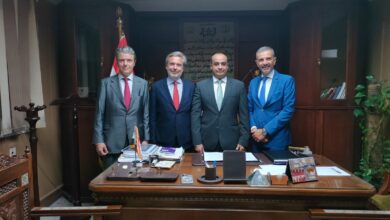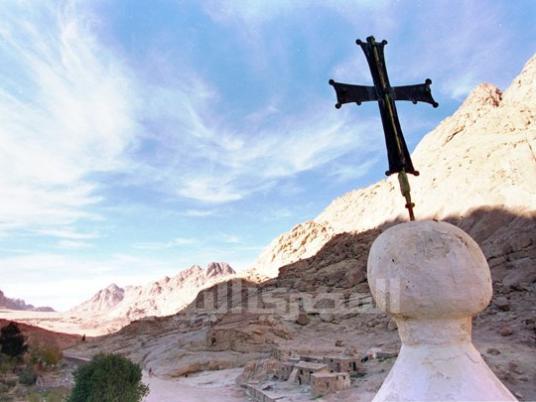The Coptic Museum in Cairo has more to offer its visitors than is generally thought. Still, only a small group of Egyptian school children and Coptic families, who visit the museum after church service, get to realize that the Coptic period is not only about Coptic Christian theology and art. The museum’s collection–the most comprehensive collection of Coptic artifacts in the world–records around eight centuries of Egypt’s diverse social, cultural, economic, religious and political life in the first millennium. Alongside icons of the Virgin Mary, Jesus Christ and monks, crosses constructed in stone reliefs and biblical manuscripts, are representations of Greek mythology, Roman iconography and Coptic styles that are very connected to Islamic art.
As soon as visitors pass the Gallery of the Masterpieces, they are met with a pilaster (a flat column) of a scene from a Greek myth in which Dionysus, the Greek god of wine, is portrayed along with Heracles, the Greek divine hero, dressed up in his wife’s robes. The inclusion of pagan art might surprise visitors who are familiar with the words Copt or Coptic pertaining only to the Christian faction that follows the Egyptian Orthodox Church. In reality, the history of Coptic art is much more inclusive.
The Coptic Museum is located in historic Old Cairo next to the Roman Fortress of Babylon and surrounded by Cairo’s oldest churches. Its facade shares an architectural style with the Al-Aqmar Mosque in Fatimid Cairo. The first is decorated with a shell Christianized with a cross, whereas the shell engraved at the center of the mosque’s facade is complemented by a medallion bearing the name of Prophet Muhammad and his companion, Ali. The shell at the Coptic museum is that of Aphrodite, a Greek deity born from the foam of the sea. It was adapted by Christian Copts and became a symbol of rebirth through baptism, and of resurrection.
The intermingled Greek, Christian and Islamic artistic and architectural styles may at first seem confusing, but they paint a complete picture. Dr. Stephen Emmel, Professor of Coptology at the American University in Cairo (AUC), explains that the designation "Coptic" is derived from “qibt,” an Arabic transcription of the Greek term for the indigenous population of Egypt who were mostly non-Arabic speaking Christians. But the term is not exclusive to Christianity.
The academic connotations of the word are more related to the Coptic writing system, the ancient Egyptian language written in the Greek alphabet complemented with seven hieroglyphic symbols. The development of the Coptic writing system was pertinent, explains Dr. Emmel, as the Egyptian Pharaonic language was dying out with the increased influence of the Greeks following Alexander the Great’s invasion of the country in 332 BC. Two groups significantly contributed to the development of Coptic writing, adds Dr. Emmel: Egyptian Christians translating the Bible from the Greek and the Manicheans, followers of an extinct Gnostic Persian religion.
The Coptic Museum’s collection shows the overlap between paganism and Christianity. It shows how each group borrowed themes, motifs and modes of representation from one another, from their shared ancestors, and from other cultures. The wreath, a Roman symbol of victory, was adapted by Coptic Christians, who added a cross at its center to symbolize the triumph of Christianity. The hieroglyphic ankh–"key to life” as it is commonly known–was also Christianized by Copts in the fourth century and appears on tablets and tombstones in the museum. The influence of Coptic artistic styles on Islamic monuments in Egypt can be seen on the facade of Al-Aqmar Mosque as well the minbar, the Islamic pulpit, which resembles the limestone pulpit from the Monastery of Saint Jeremiah, which is exhibited at the museum.
The museum also highlights the origins of monasticism. Saint Antony, the father of the monks, was an Egyptian Coptic Christian, who lived an ascetic life on a mountain near the Red Sea. “Life of Antony,” a biography written by the Patriarch of Alexandria, Athanasius, after the saint’s death, introduced the monastic ideal to the West and set the example for the hermetic lifestyle of monks. The development of monasticism in Egypt is traced through the museum’s chronological display of wall reliefs and ornaments from the monasteries of Saint Jeremiah and Saint Apollo.
Another interesting collection is that of codices from the Nag Hammadi Library. Codices are the form of books that replaced the impractical scroll. The binding techniques used in book making today are based on those thought to be developed by the Copts. The Nag Hammadi Library consists of thirteen codices that were discovered in a jar in 1945 by a camel drive in Upper Egypt. These Coptic manuscripts are the primary source for the study of the Gnostic religious movement, which called for liberating the human spirit from the confines of the human body.
So why has the Coptic Museum’s expansive collection had such little appeal to Egyptians? Is it due to a lack of perceived relevance by the Egyptian Muslim majority? Egyptian schools have historically paid minimal attention to Coptic history, but that might gradually change with the recent introduction of a session on the subject in fifth grade curriculum. A knowledge of the period might make the collection identifiable to a larger group of people, and help them overcome existing prejudices and misconceptions. In the end, what we choose to see, perceive and remember is culturally constructed.
The Coptic Museum is located in Old Cairo and is organizing an exhibition from its collection under the title “Coptic Art Revealed” at the Palace of Amir Taz from 29 November 2010 until 31 January 2011.




